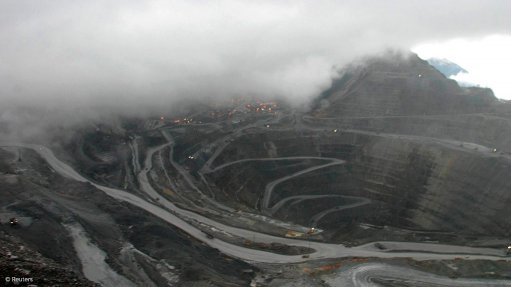Strategic application of simultaneous optimisation techniques across the mining portion of the value chain
By: Steve Burks
In the first of four columns, I suggested a modified approach to business planning and implementation of potential improvements for the minerals industry. This second column focuses on the strategic portion of this approach, the application of simultaneous optimisation techniques across the mining portion of the value chain. I draw significantly on the experience I gained while working for Australia’s Whittle Consulting.
African mining operations and projects rarely optimise the entire value chain and often only consider one or two elements. This means optimised solutions are developed independently of each other.
Ideally, simultaneous optimisation should begin with the mining steps of the operation or project and be applied to both openpit and underground mines – with the openpit outer shell as the starting point.
The general design approach for a pit shell has conventionally been done to maximise total net cash flow. But this means that you are regarding the cash generated at the end of the mine’s life – perhaps 20 years away – as having the same value as it has today. However, prices rise every year and a rand or a dollar earned today will not necessarily have the same buying power in a few years’ time.
When this year’s discount factor is taken into account, the economic viability of the pit or underground orebody will be slightly reduced in size. The resource that will actually be mined is identified and quantified in the shell optimisation step. All subsequent optimisation steps then also focus on discounted cash flow with the objective of increasing the net present value or sum of annual discounted cash flows of an operation by 5% to 35%, according to Whittle Consulting.
The next step is to consider phases or push-backs within an openpit. The worst-case mining solution would be to mine horizontal slices across the whole area of the pit until the orebody is reached 50 m or more below surface. The first year or two of mining would therefore only mine waste with no value at all.
Instead of this, the enterprise should sink an initial starter pit located above the ore with highest net value to reach the orebody as fast as possible and then continue accessing it from a concentric series of benches around the first phase. This technique is used by nearly all hard-rock mineral mines but some openpit coal mines still do not apply phase optimisation.
Turning to underground mining, phasing principles can still be applied, although there is no generic mathematical solution as there is with openpits. As an example, consider a massive, reasonably flat, underground orebody.
In this instance, one should sink a shaft to access the highest-value portion of the orebody as quickly as possible, while also providing the flexibility of extracting the ore in any horizontal direction.
The idea is to break the orebody up into zones underground and define the order or alternative sequences in which the zones can be mined. Selection of the most beneficial sequences as well as the optimal mining thickness for each zone results in a mining plan accessing the highest-value material earlier than the unoptimised plan, and will also define the extent of the orebody shell mined underground just as if it were an openpit shell.
Following the orebody shell and sequence optimisation, the remaining mining steps are the same for openpits and underground mines. First, the mining schedule in each pushback or zone is optimised to bring forward net cash flow. Next, cutoff grade optimisation is applied. In simple terms, the principle is that the grade of the ore mined and processed to generate revenue will decline from a high value at the commencement of operations to a much lower value at the end of the life-of-mine, whereas unoptimised plans often show a constant grade mined throughout the entire period of operation.
The final mining optimisation step is stockpiling, which proposes the establishment of strategic low-value stockpiles of ore between mining and processing. The highest possible value ore bypasses these stockpiles and is processed early on, with stockpiles being reclaimed and processed in later years.
These mining steps are then optimised simultaneously using Whittle’s advanced software.
It is similar to the iteration of a mine’s business plan, where most business planning processes perhaps go through two or three iterations. The simultaneous optimisation can mimic hundreds of iterations in no more than a day or two, usually resulting in a much better financial outcome.
The basic model applied by Whittle is illustrated in the graphic. In summary, the process aims to maximise the achievable discounted cash flow of the entire operation or project over its whole life-of-mine by considering each of the separate modules shown in the diagram in red. A simultaneous solution for the entire value chain is then generated, taking into account techniques, mechanisms, constraints and opportunities identified by others and commonly applied by nonmining industries to optimise their operations, such as the Theory of Constraints, activity-based costing, geometallurgy, sustainability and risk.
Steve Burks, an Associate Director of Johannesburg-based MAC Consulting, a management consulting group specialising in mining, oil and gas, financial services and telecommunications suggests that this could be the case, and offers some suggestions about how the situation might be improved. Prior to joining MAC Consulting, Burks had completed 30 successful optimisation studies over the past four years in Africa on behalf of Australia’s Whittle Consulting. This in turn followed nearly 20 years spent working for Bateman Engineering where Burks was involved in feasibility studies, project delivery, technology commercialisation, change management and business acquisitions and start-ups for mining related operations and projects in many countries.
Comments
Press Office
Announcements
What's On
Subscribe to improve your user experience...
Option 1 (equivalent of R125 a month):
Receive a weekly copy of Creamer Media's Engineering News & Mining Weekly magazine
(print copy for those in South Africa and e-magazine for those outside of South Africa)
Receive daily email newsletters
Access to full search results
Access archive of magazine back copies
Access to Projects in Progress
Access to ONE Research Report of your choice in PDF format
Option 2 (equivalent of R375 a month):
All benefits from Option 1
PLUS
Access to Creamer Media's Research Channel Africa for ALL Research Reports, in PDF format, on various industrial and mining sectors
including Electricity; Water; Energy Transition; Hydrogen; Roads, Rail and Ports; Coal; Gold; Platinum; Battery Metals; etc.
Already a subscriber?
Forgotten your password?
Receive weekly copy of Creamer Media's Engineering News & Mining Weekly magazine (print copy for those in South Africa and e-magazine for those outside of South Africa)
➕
Recieve daily email newsletters
➕
Access to full search results
➕
Access archive of magazine back copies
➕
Access to Projects in Progress
➕
Access to ONE Research Report of your choice in PDF format
RESEARCH CHANNEL AFRICA
R4500 (equivalent of R375 a month)
SUBSCRIBEAll benefits from Option 1
➕
Access to Creamer Media's Research Channel Africa for ALL Research Reports on various industrial and mining sectors, in PDF format, including on:
Electricity
➕
Water
➕
Energy Transition
➕
Hydrogen
➕
Roads, Rail and Ports
➕
Coal
➕
Gold
➕
Platinum
➕
Battery Metals
➕
etc.
Receive all benefits from Option 1 or Option 2 delivered to numerous people at your company
➕
Multiple User names and Passwords for simultaneous log-ins
➕
Intranet integration access to all in your organisation





















